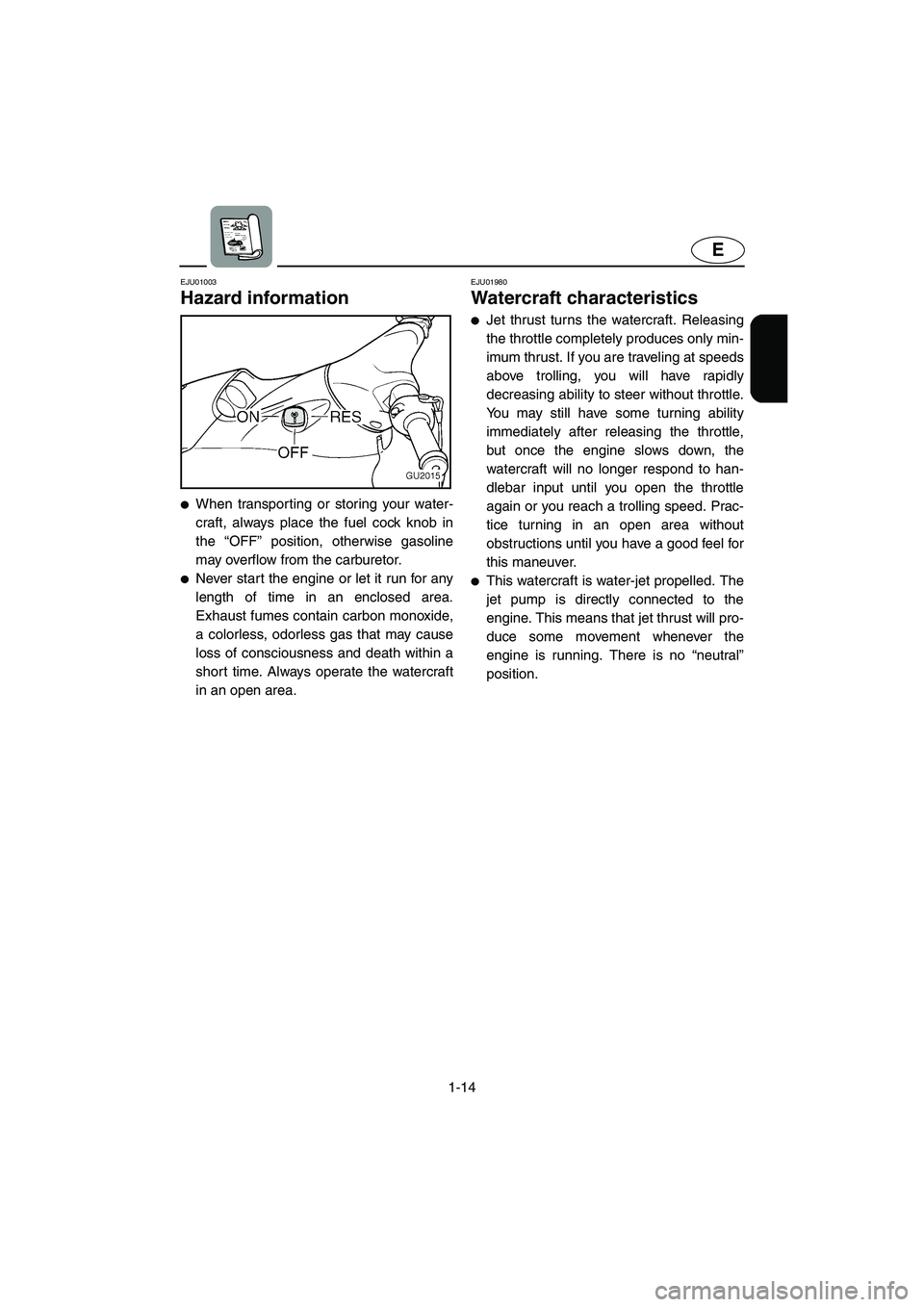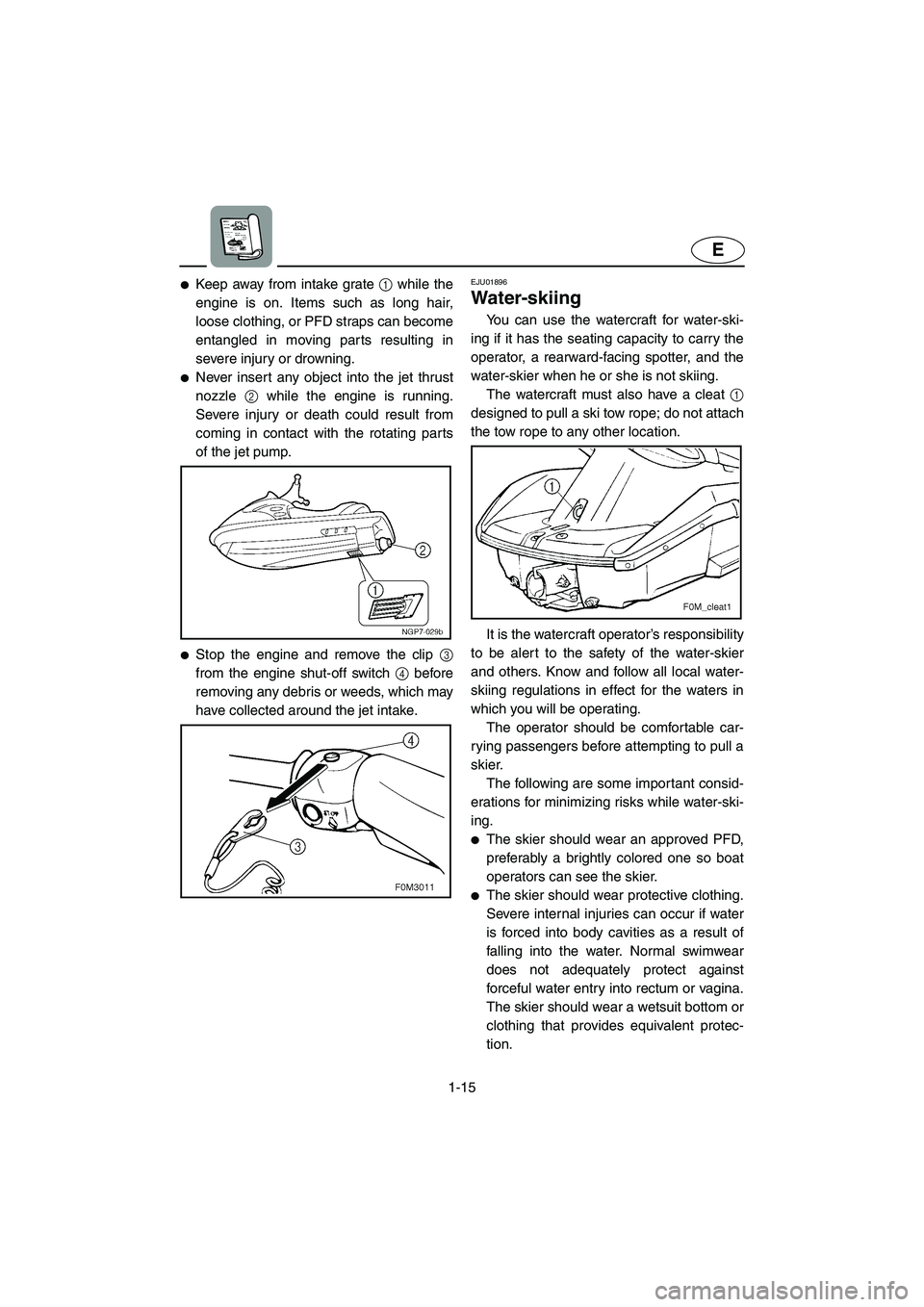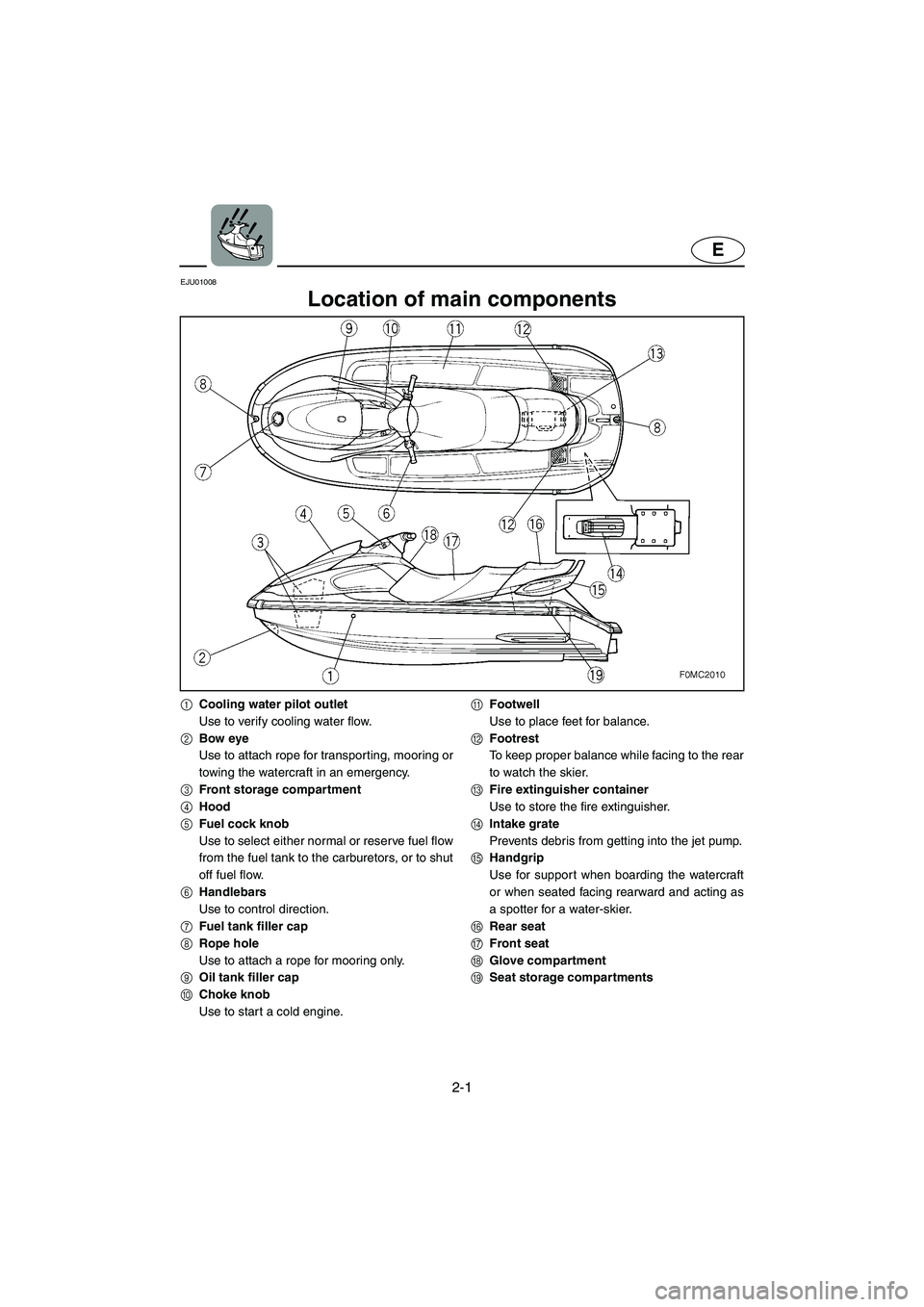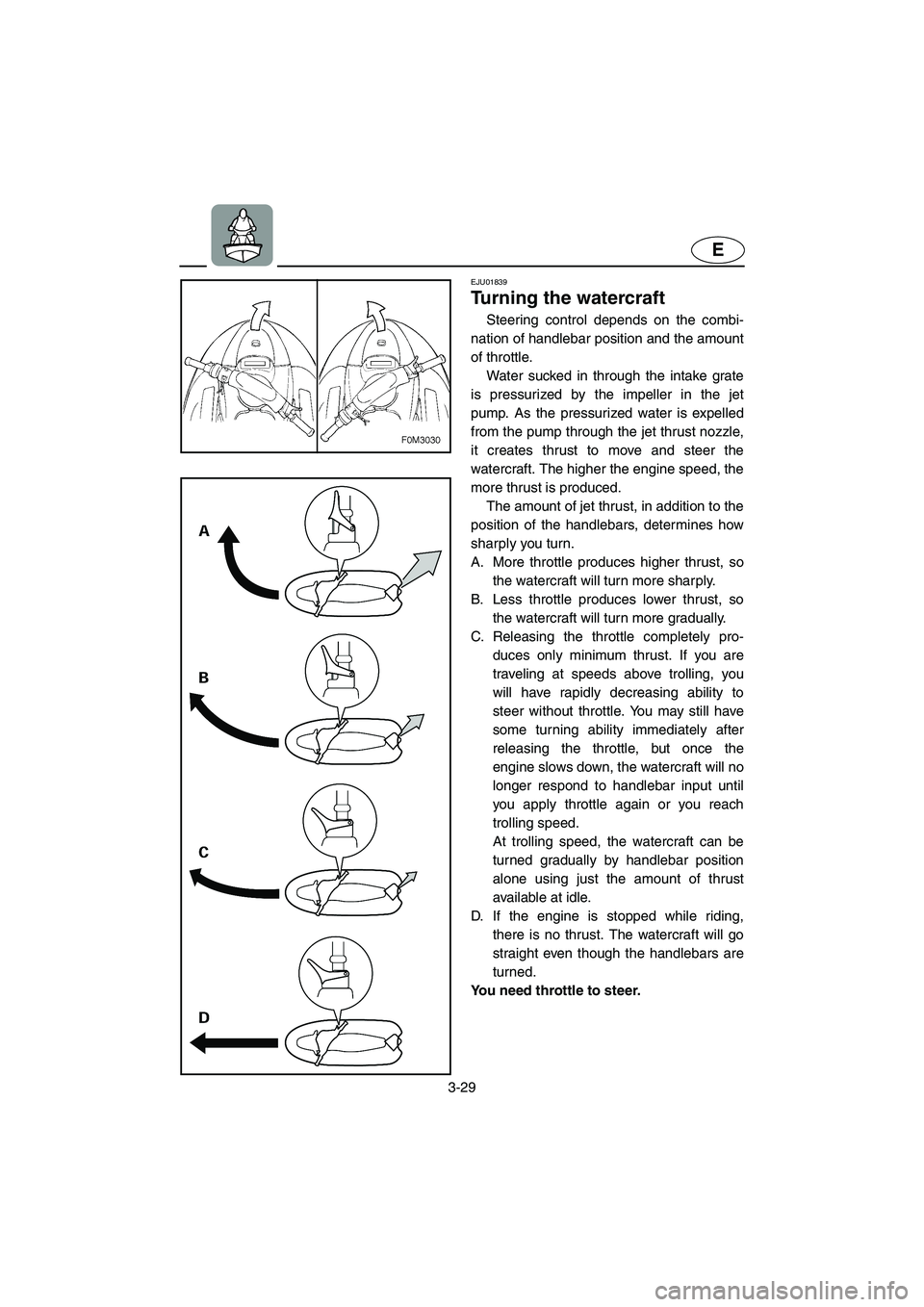Page 21 of 120

1-14
E
EJU01003
Hazard information
�When transporting or storing your water-
craft, always place the fuel cock knob in
the “OFF” position, otherwise gasoline
may overflow from the carburetor.
�Never start the engine or let it run for any
length of time in an enclosed area.
Exhaust fumes contain carbon monoxide,
a colorless, odorless gas that may cause
loss of consciousness and death within a
short time. Always operate the watercraft
in an open area.
EJU01980
Watercraft characteristics
�Jet thrust turns the watercraft. Releasing
the throttle completely produces only min-
imum thrust. If you are traveling at speeds
above trolling, you will have rapidly
decreasing ability to steer without throttle.
You may still have some turning ability
immediately after releasing the throttle,
but once the engine slows down, the
watercraft will no longer respond to han-
dlebar input until you open the throttle
again or you reach a trolling speed. Prac-
tice turning in an open area without
obstructions until you have a good feel for
this maneuver.
�This watercraft is water-jet propelled. The
jet pump is directly connected to the
engine. This means that jet thrust will pro-
duce some movement whenever the
engine is running. There is no “neutral”
position.
UF0M75.book Page 14 Thursday, May 29, 2003 9:53 AM
Page 22 of 120

1-15
E
�Keep away from intake grate 1 while the
engine is on. Items such as long hair,
loose clothing, or PFD straps can become
entangled in moving parts resulting in
severe injury or drowning.
�Never insert any object into the jet thrust
nozzle 2 while the engine is running.
Severe injury or death could result from
coming in contact with the rotating parts
of the jet pump.
�Stop the engine and remove the clip 3
from the engine shut-off switch 4 before
removing any debris or weeds, which may
have collected around the jet intake.
EJU01896
Water-skiing
You can use the watercraft for water-ski-
ing if it has the seating capacity to carry the
operator, a rearward-facing spotter, and the
water-skier when he or she is not skiing.
The watercraft must also have a cleat 1
designed to pull a ski tow rope; do not attach
the tow rope to any other location.
It is the watercraft operator’s responsibility
to be alert to the safety of the water-skier
and others. Know and follow all local water-
skiing regulations in effect for the waters in
which you will be operating.
The operator should be comfortable car-
rying passengers before attempting to pull a
skier.
The following are some important consid-
erations for minimizing risks while water-ski-
ing.
�The skier should wear an approved PFD,
preferably a brightly colored one so boat
operators can see the skier.
�The skier should wear protective clothing.
Severe internal injuries can occur if water
is forced into body cavities as a result of
falling into the water. Normal swimwear
does not adequately protect against
forceful water entry into rectum or vagina.
The skier should wear a wetsuit bottom or
clothing that provides equivalent protec-
tion.
UF0M75.book Page 15 Thursday, May 29, 2003 9:53 AM
Page 26 of 120

2-1
E
EJU01008
Location of main components
1Cooling water pilot outlet
Use to verify cooling water flow.
2Bow eye
Use to attach rope for transporting, mooring or
towing the watercraft in an emergency.
3Front storage compartment
4Hood
5Fuel cock knob
Use to select either normal or reserve fuel flow
from the fuel tank to the carburetors, or to shut
off fuel flow.
6Handlebars
Use to control direction.
7Fuel tank filler cap
8Rope hole
Use to attach a rope for mooring only.
9Oil tank filler cap
0Choke knob
Use to start a cold engine.AFootwell
Use to place feet for balance.
BFootrest
To keep proper balance while facing to the rear
to watch the skier.
CFire extinguisher container
Use to store the fire extinguisher.
DIntake grate
Prevents debris from getting into the jet pump.
EHandgrip
Use for suppor t when boarding the watercraft
or when seated facing rearward and acting as
a spotter for a water-skier.
FRear seat
GFront seat
HGlove compartment
ISeat storage compartments
UF0M75.book Page 1 Thursday, May 29, 2003 9:53 AM
Page 38 of 120
2-13
E
EJU01131
Engine overheat warning
system
This model is equipped with an engine
overheat warning system.
If the engine starts to overheat, the
engine speed will be limited to about
3,400 r/min.
When this occurs, check for water dis-
charge at the cooling water pilot outlet. If
there is no discharge of water, reduce the
engine speed and beach the watercraft, and
then check the intake grate and impeller for
clogging.
WARNING@ Before attempting to remove weeds or
debris from the intake grate or impeller,
shut the engine off and remove the clip
from the engine shut-off switch. Severe
injury or death could result from coming
in contact with the rotating parts of the
jet pump.
@
CAUTION:@ If you cannot locate and correct the
cause of the overheating, consult a
Yamaha dealer. Continuing to operate at
higher speeds could result in severe
engine damage.
@
UF0M75.book Page 13 Thursday, May 29, 2003 9:53 AM
Page 45 of 120
3-2
E
�If any gasoline spills onto your skin,
immediately wash with soap and
water. Change clothing if gasoline
spills on it.
@
CAUTION:@ Use only fresh gasoline that has been
stored in clean containers.
@
EJU01832
Gasohol
There are two types of gasohol: gasohol
containing ethanol and that containing meth-
anol.
Gasohol containing ethanol can be used
if ethanol content does not exceed 10% and
the fuel meets minimum octane ratings.
Gasohol containing methanol is not rec-
ommended by Yamaha because it can
cause fuel system damage or engine perfor-
mance problems.
EJU10441
2-stroke engine oil
If YAMALUBE 2-W oil is not available,
another 2-stroke engine oil with an NMMA-
certified TC-W3 rating may be used. Recommended gasoline:
Regular unleaded gasoline with a
minimum octane rating of
86 (Pump octane number) = (R+M)/2
90 (Research octane number)
Recommended engine oil:
YAMALUBE 2-W oil
UF0M75.book Page 2 Thursday, May 29, 2003 9:53 AM
Page 55 of 120

3-12
E
EJU01058
Jet unit
Carefully check the jet intake for weeds,
debris, or anything else that might restrict
the intake of water. If the intake is clogged,
cavitation could occur, reducing jet thrust,
and possibly damaging the jet pump.
In some cases, the engine may overheat
because of lack of cooling water, and dam-
age to the engine could result. Engine cool-
ing water is fed to the engine by the jet
pump. (See page 5-4 for jet intake cleaning
procedures.)
WARNING@ �Keep away from intake grate while
engine is on. Items such as long hair,
loose clothing, or PFD straps can
become entangled in moving parts
resulting in severe injury or drowning.
�Stop the engine and remove the clip
from the engine shut-off switch before
removing any debris or weeds, which
may have collected around the jet
intake.
@
EJU01059
Engine shut-off cord (lanyard)
Check that the engine shut-off cord is not
frayed or broken. If the cord is damaged,
replace it; never try to repair it or tie it
together.
UF0M75.book Page 12 Thursday, May 29, 2003 9:53 AM
Page 61 of 120
3-18
E
5. While lightly squeezing the throttle lever,
push the start switch (green button).
WARNING@ On this watercraft, the engine is con-
nected directly to the jet pump. Starting
the engine immediately generates some
thrust. Apply only enough throttle to
keep the engine running.
@
6. Release the start switch as soon as the
engine starts to run.
CAUTION:@ �Never push the start switch while the
engine is running.
�Do not operate the start switch for
more than 5 seconds, otherwise the
battery will be discharged and the
engine will not start. Also, the starter
motor may be damaged. If the engine
does not start in 5 seconds, release
the start switch, wait 15 seconds, and
try again.
@
7. After the engine has warmed up, push
the choke knob in to its original position.
NOTE:@ If the choke knob is left pulled out, the
engine will stall.
@
UF0M75.book Page 18 Thursday, May 29, 2003 9:53 AM
Page 72 of 120

3-29
E
EJU01839
Turning the watercraft
Steering control depends on the combi-
nation of handlebar position and the amount
of throttle.
Water sucked in through the intake grate
is pressurized by the impeller in the jet
pump. As the pressurized water is expelled
from the pump through the jet thrust nozzle,
it creates thrust to move and steer the
watercraft. The higher the engine speed, the
more thrust is produced.
The amount of jet thrust, in addition to the
position of the handlebars, determines how
sharply you turn.
A. More throttle produces higher thrust, so
the watercraft will turn more sharply.
B. Less throttle produces lower thrust, so
the watercraft will turn more gradually.
C. Releasing the throttle completely pro-
duces only minimum thrust. If you are
traveling at speeds above trolling, you
will have rapidly decreasing ability to
steer without throttle. You may still have
some turning ability immediately after
releasing the throttle, but once the
engine slows down, the watercraft will no
longer respond to handlebar input until
you apply throttle again or you reach
trolling speed.
At trolling speed, the watercraft can be
turned gradually by handlebar position
alone using just the amount of thrust
available at idle.
D. If the engine is stopped while riding,
there is no thrust. The watercraft will go
straight even though the handlebars are
turned.
You need throttle to steer.
UF0M75.book Page 29 Thursday, May 29, 2003 9:53 AM